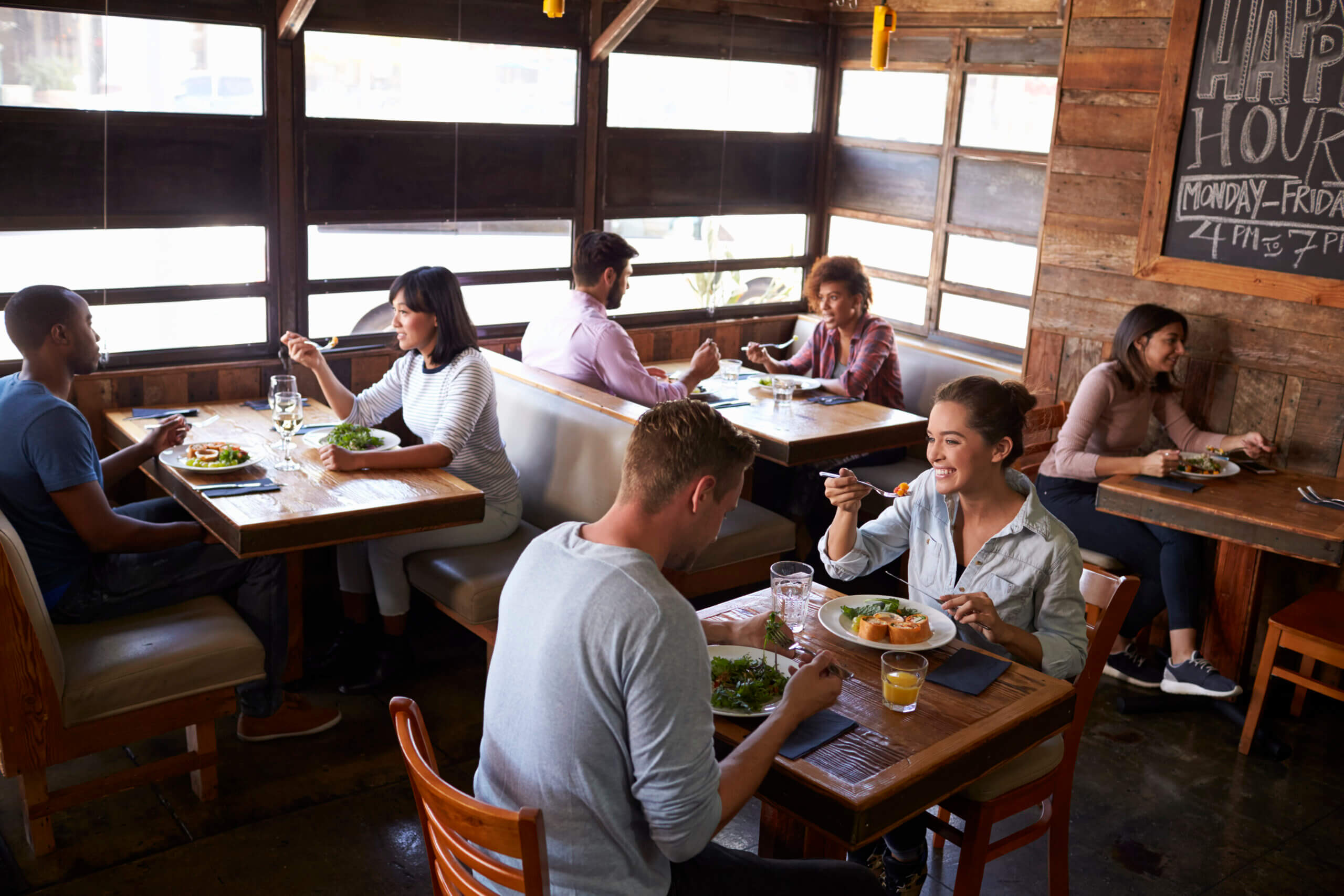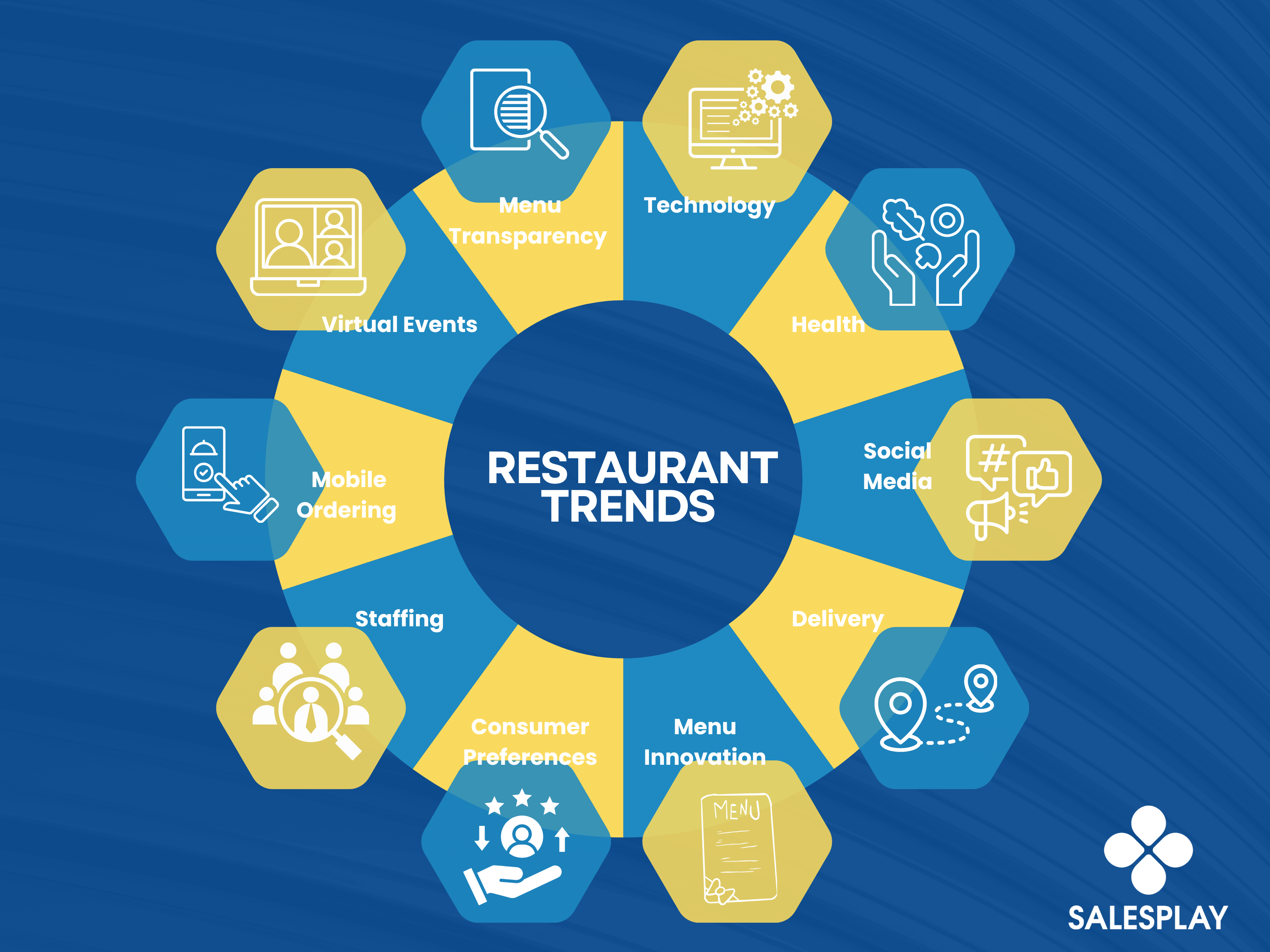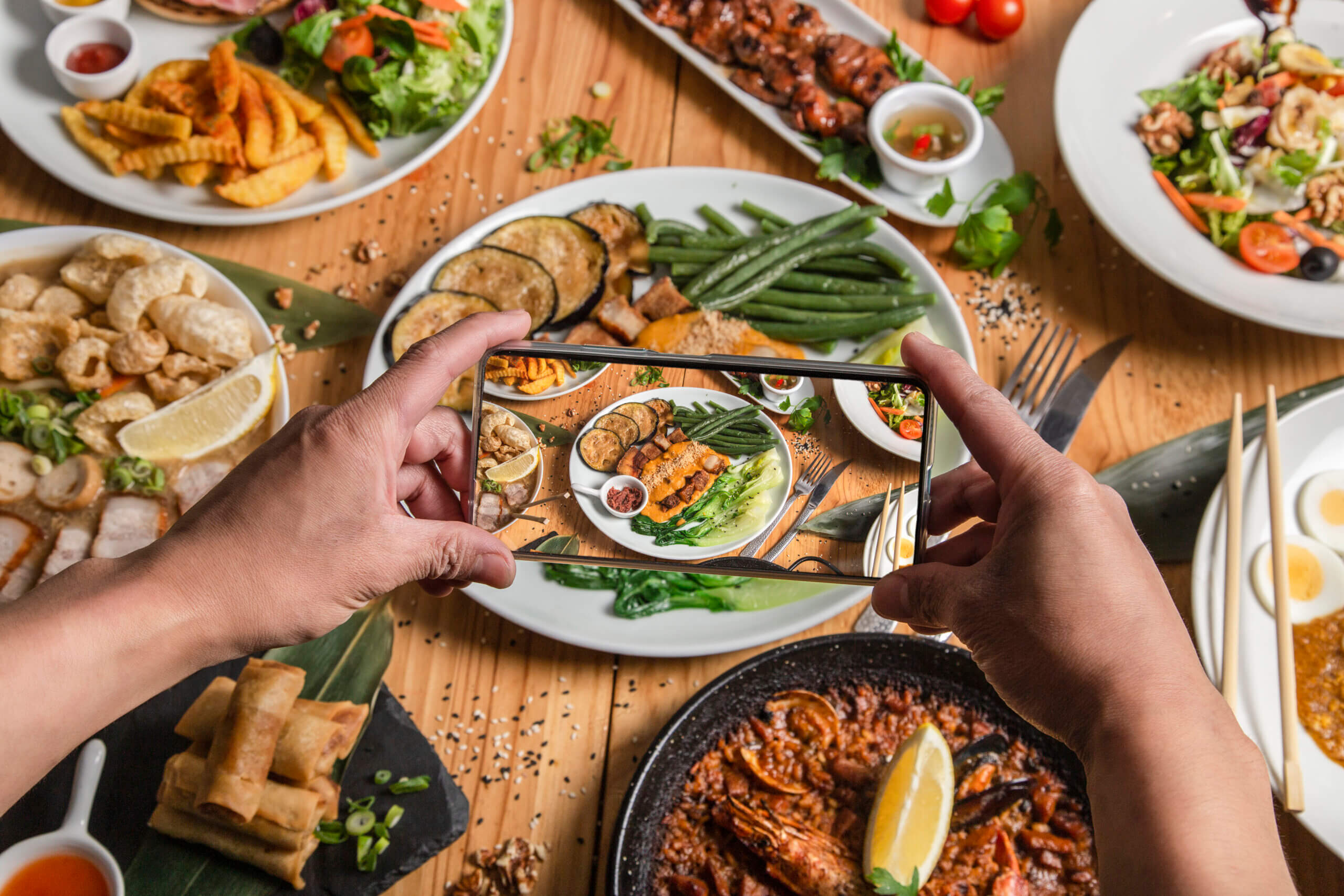The restaurant industry is rapidly evolving, driven by emerging consumer behaviors, technological advancements, and changing market dynamics. In 2025, staying ahead of these shifts is crucial for success, and leveraging a restaurant POS system can play a significant role in navigating these changes effectively.

This article explores the key restaurant trends and restaurant consumer trends that are shaping the future of dining, offering insights into how businesses can adapt and thrive. From the rise of quick service restaurants to the importance of loyalty programs, we delve into the challenges and opportunities these trends present.
Whether you're a restaurant owner, manager, or an avid diner, this guide will help you navigate the dynamic landscape of the restaurant industry in 2025.

Technology continues to revolutionize the restaurant industry, enhancing efficiency, customer experience, and profitability.
In 2025, online ordering and delivery have become integral to restaurant operations, especially for quick service restaurants.
Platforms like UberEats and DoorDash continue to attract consumers with their convenience. These services have been integrated by restaurants directly into their operations to streamline processes and improve delivery efficiency.
Another important technological trend in the restaurant industry is the adoption of contactless payment systems. The shift to contactless payments has become more entrenched, driven by consumer demand for seamless and hygienic payment options.
Mobile wallets, NFC-enabled cards, and QR code payments are now standard, providing a quicker, safer checkout experience that aligns with evolving restaurant consumer trends.

Data analytics has become a game-changer for understanding consumer behaviors. By analyzing customer data, restaurants can tailor their offerings, optimize menus, and personalize marketing efforts.
This data-driven approach improves customer satisfaction and encourages repeat business through targeted loyalty programs.
Learn more regarding restaurant data analytics
Smart kitchens and automated systems are becoming more common, helping restaurants optimize operations and reduce waste.
Innovations such as AI-powered kitchen assistants and predictive inventory management ensure that restaurants can meet demand while minimizing costs.
In 2025, maintaining a strong digital presence is vital. Restaurants are using social media to learn more about customer behavior in addition to using it for marketing purposes.
Platforms like Instagram, TikTok, and X (formerly Twitter) are used to showcase dishes, promote events, and engage directly with customers, building brand loyalty and attracting new patrons.

Overall, technology is having a significant impact on the restaurant industry, changing the way customers order and pay for their meals and how restaurants design their kitchens and dining rooms. Staying up to date with the latest technology trends will enable restaurants to remain competitive and offer the best possible experience to their customers.
The restaurant industry is getting a makeover with the rise of health and wellness trends.
Folks are becoming more conscious of the food they eat, allergies and intolerances, and demanding more information about their meals.
Customers now seek healthy options that are low in calories, fat, and sodium, and high in protein, fiber, and other nutrients.
Restaurants are adjusting their menus and marketing strategies to meet the growing demand for health and wellness, which continues to shape consumer preferences.
There is a growing trend among consumers to demand transparency regarding the food they eat. Restaurants are responding by providing detailed nutritional information and serving meals that appeal to patrons who are health conscious.

This includes an emphasis on fresh, locally sourced ingredients and menu items that are low in calories, fat, and sodium but high in nutrients.
The plant-based movement shows no signs of slowing down in 2025. Restaurants are expanding their vegetarian and vegan offerings to attract a broader audience.
These options are not just for vegans anymore, they appeal to a wide range of diners interested in healthier, more sustainable eating habits.
Personalized dining experiences are offered by restaurants with the help of technology. Customers can now customize their orders to fit their dietary needs and preferences through mobile apps and online platforms.
This trend is especially popular in quick service restaurants, where speed and personalization are key.
Restaurants are also incorporating technology into their operations to better serve their health-conscious customers. For example, some are using mobile apps and online ordering platforms that allow customers to customize their orders. Others are using data analytics to track customer behavior and preferences, enabling them to tailor their offerings accordingly.
Social media remains a powerful tool for engaging with customers and building a restaurant’s brand in 2025. As discussed above, platforms like Facebook, Instagram, and Twitter have become crucial for customers to explore new dining options, share their experiences, and connect with their favorite brands.
To keep up with this trend, restaurants are investing in social media marketing and implementing strategies to engage with customers on these platforms
Restaurants are using social media to visually showcase their dishes, making platforms like Instagram essential for driving traffic.
High-quality photos and videos of signature dishes, paired with engaging captions, can entice customers to visit their establishment and try their offerings.
Engagement goes beyond just posting. Restaurants are creating communities by interacting with their followers, reposting user-generated content, and hosting online contests. These interactions help the development of a loyal customer base that feels connected to the brand.
Discover more effective ways to increase customer loyalty in your restaurant.
Influencer Collaborations
Collaborations with influencers continue to be a key strategy to expand their reach and tap into new customer segments. By partnering with food bloggers and social media personalities, restaurants can reach new audiences and create buzz around their offerings.
This is particularly effective for promoting new menu items or seasonal specials.
Social media platforms provide a wealth of data about consumer behaviors. By analyzing this data, restaurants can better understand their customers’ preferences and tailor their marketing strategies accordingly. This insight is invaluable for staying ahead of trends and maintaining a competitive edge.
Overall, social media has become one of the crucial trends in the restaurant industry, as customers increasingly rely on these platforms to discover new dining options, connect with brands, and share their experiences.
By investing in social media marketing, engaging with customers on social media platforms, and leveraging social media data and insights, restaurants can build brand awareness, increase customer loyalty, and stay ahead of the competition in this rapidly evolving industry.
Let’s discover 5 Must-Know Restaurant Marketing Trends for 2025, that every business owner needs to know to stay ahead.
The demand for delivery and takeout continues to grow, reshaping how restaurants operate. Restaurants are adapting by offering delivery and takeout options and putting in place strategies to keep up with customer demands.
Partnering up with third-party delivery services such as Uber Eats, Grubhub, and DoorDash remains a popular strategy for expanding reach and meeting customer demand.

In 2025, more restaurants are opting for hybrid models, offering both in-house delivery and third-party options to maximize efficiency and customer satisfaction.
Menus are being tailored for delivery to ensure that dishes arrive in perfect condition.
Packaging innovations and menu adjustments help maintain the quality and presentation of food during transit, addressing a key concern for consumers.
Curbside pickup and contactless delivery have become standard offerings, providing customers with convenient, low-contact options. These services cater to the ongoing consumer preference for speed and safety.
Learn more regarding curbside pickup and contactless delivery
Restaurants are exploring new revenue streams by offering meal kits, catering services, and subscription-based meal plans.
These options cater to the growing number of consumers who prefer to dine at home but still want a restaurant-quality experience.
In a competitive market, menu innovation is crucial for attracting and retaining customers.
Let’s explore a Menu AR: Experience restaurant menus in augmented reality, making every dining decision more exciting and immersive!
Restaurants are increasingly experimenting with global flavors and fusion cuisine, offering unique dishes that combine elements from different culinary traditions.
This approach attracts adventurous eaters and taps into the growing trend of cultural diversity in dining.
Sustainability continues to influence consumer behaviors. Restaurants are focusing on ethically sourced ingredients, reducing food waste, and highlighting sustainable practices in their menus.
This not only appeals to eco-conscious consumers but also enhances a restaurant's brand reputation.
Discover why your restaurant needs to practice sustainable sourcing.
Customization remains a key trend, especially in quick service restaurants.
Offering build-your-own options for salads, bowls, and pizzas allows customers to create meals that suit their tastes and dietary needs. This flexibility is highly valued by today’s consumers.
Innovative presentation and interactive dining experiences are becoming more popular.
Restaurants are using creative plating techniques, interactive elements like tableside cooking, and even augmented reality to enhance the dining experience and create memorable moments for their customers.
Understanding and adapting to changing consumer behaviors is crucial for success in the restaurant industry.
Consumers are increasingly prioritizing health and sustainability in their dining choices. Restaurants that offer nutritious, sustainable options are more likely to attract and retain customers.
This trend is driving the growth of farm-to-table concepts, as well as the inclusion of more plant-based dishes on menus.
The demand for convenience and speed is reshaping the restaurant landscape. With busy lifestyles, consumers are looking for quick, easy, and reliable dining options.
This has led to the continued growth of quick service restaurants and the expansion of mobile ordering and payment systems.
Beyond just food, consumers are seeking unique and memorable dining experiences.

Whether it’s through themed restaurants, live entertainment, or interactive dining, offering something beyond the ordinary can set a restaurant apart and create lasting customer loyalty.
Loyalty programs have become an essential tool for retaining customers in 2025.
By offering rewards, personalized offers, and exclusive experiences, restaurants can encourage repeat business and build long-term relationships with their customers.
Learn how to set up a customer loyalty program in SalesPlay to driving engagement and seamlessly reward your valued customers.
Labor challenges remain a significant issue in the restaurant industry, with staffing shortages and high turnover rates persisting.
Restaurants are adopting more flexible staffing solutions, including part-time positions, gig work, and cross-training employees to perform multiple roles. This approach helps manage labor costs and ensures that restaurants can maintain high service levels, even during peak times.
To attract and retain talent, restaurants are focusing on employee wellbeing. This includes offering competitive wages, benefits, and opportunities for career advancement. Additionally, a focus on work-life balance and a positive workplace culture are becoming key factors in employee retention.
Investing in employee training and development is crucial for improving service quality and reducing turnover. Restaurants are implementing comprehensive training programs. These cover everything from culinary skills to customer service, helping employees excel and feel valued.
As labor shortages persist, automation and technology are playing a larger role in restaurant operations. From self-order kiosks to robotic kitchen assistants, these innovations help reduce the reliance on human labor while improving efficiency and consistency.
Let’s explore more on how labor shortages are affecting your restaurant’s profits and explore strategies to mitigate the effects on your operations and bottom line.
Mobile ordering and payment are one of the hot trends in the restaurant industry these days, as diners are increasingly using their smartphones and tablets to make meal orders and settle bills. This modern convenience has made dining out a breeze, especially for customers who are always on the move and don't have time to waste

One of the biggest advantages of mobile ordering and payment is that it saves time for customers. With just a few clicks, orders can be placed, and bills can be settled in a jiffy. This not only helps customers avoid long wait times but also enhances their overall dining experience.
Moreover, mobile ordering and payment is a smart way for restaurants to increase revenue and customer loyalty. By providing a smooth and user-friendly ordering and payment experience, restaurants can win over customers who value convenience and speed. Additionally, this technology enables restaurants to gather valuable customer data and feedback, which can be utilized to enhance their menus and services and attract even more customers.
In addition to this, mobile ordering and payment also helps restaurants cut down on labor costs and streamline their operations. By automating the ordering and payment process, restaurants can eliminate the need for staff to handle cash and credit card transactions, thus saving valuable time and resources.
Finally, restaurants that offer mobile ordering and payment are better equipped to cater to the evolving needs and preferences of their customers. As more and more customers embrace mobile technology to manage their daily lives, restaurants that don't offer mobile ordering and payment risk losing out to their tech-savvy competitors.
Overall, the mobile ordering and payment trend is a game-changer for the restaurant industry, as it enables restaurants to keep up with the changing times and meet the ever-evolving demands of their customers. By offering a seamless and hassle-free ordering and payment process, restaurants can boost their sales, win customer loyalty, and stay ahead of the competition.
Virtual events and experiences are all about using the power of technology to create unforgettable moments for customers. This trend has exploded in recent years, as more and more people are looking for novel and exciting dining experiences.
One of the most significant benefits of virtual events and experiences is their ability to connect with people all over the world. By tapping into online platforms, restaurants can showcase their offerings to a global audience and create immersive experiences that transcend physical barriers. This is particularly crucial for restaurants that want to expand their reach and raise brand awareness.
Moreover, virtual events and experiences offer a chance to create deep connections with customers, foster a sense of community, and build loyalty. By crafting experiences that go beyond the usual dining fare, restaurants can establish a strong bond with customers and earn their repeat business. The feeling of being part of an exclusive and unique event can be quite compelling, and people are more likely to share their positive experiences with others.
Discover more how to build a restaurant community around your business.
In addition, virtual events and experiences provide an opportunity for restaurants to stand out from the crowd and differentiate themselves from their competitors.
Restaurants that offer one-of-a-kind experiences not found elsewhere can attract new customers and retain existing ones. People are always looking for something new and exciting, and restaurants that can deliver that will stay top of mind.
Restaurants that offer one-of-a-kind experiences not found elsewhere can attract new customers and retain existing ones.
Finally, virtual events and experiences allow restaurants to adapt to changing customer behaviors and preferences. As people increasingly seek personalized and immersive experiences, restaurants that embrace this trend are likely to have an edge over those that don't.
Overall, virtual events and experiences are a crucial component of the restaurant industry. Restaurants that can offer innovative and engaging experiences will be able to build strong relationships with customers, stand out from their competitors, and drive repeat business.
Menu transparency, the practice of providing detailed information about the ingredients and nutritional content of dishes on a restaurant's menu, has gained popularity as customers become more interested in making informed food choices.
One advantage of menu transparency is the potential to build trust and credibility with customers. By providing transparent information about their dishes, restaurants can demonstrate their commitment to quality and customer satisfaction, which can lead to a loyal customer base and improve their reputation.
Menu transparency also has the potential to increase sales and revenue. With a growing demand for healthy and sustainable food options, providing detailed information about ingredients and nutritional content can attract health-conscious customers and drive sales of perceived healthier dishes.
Moreover, menu transparency can also help restaurants comply with food safety regulations and reduce the risk of foodborne illnesses. Providing customers with information about allergens and other potential food contaminants can help them make informed decisions and avoid potential health risks.
Finally, menu transparency can also help restaurants differentiate themselves from their competitors and stand out in a crowded marketplace. By providing transparent information about their dishes, restaurants can show their commitment to quality and customer satisfaction and build a loyal following.
Overall, menu transparency is a critical aspect of the restaurant industry, as restaurants must adapt to changing customer needs and preferences. By providing detailed information about their dishes, restaurants can build trust with customers, comply with food safety regulations, attract health-conscious customers, and differentiate themselves from their competitors.
While many POS systems stop at basic sales tracking, SalesPlay POS goes further with optional add-ons that directly address some of the biggest challenges restaurants face today.
Inventory Management Add-On – Track stock in real-time, receive low-stock alerts, generate purchase orders, and reduce waste. With predictive inventory tools, managers can ensure the kitchen is always prepared without overstocking.
Employee Management Add-On – Monitor staff performance, track sales by employee, manage shifts, and automate commissions. This feature not only boosts accountability but also helps restaurants reward top performers and maintain smooth service during peak hours.
By combining these advanced features with its cloud POS system, SalesPlay empowers restaurants to improve efficiency, reduce costs, and deliver a consistently better dining experience in 2025 and beyond.
1. What are the biggest restaurant trends in 2025?
In 2025, restaurants are focusing on technology adoption, health-conscious menus, menu transparency, social media engagement, and delivery convenience. Trends like mobile ordering, loyalty programs, and sustainability practices are shaping how restaurants operate and connect with customers.
2. Why is technology important for restaurants today?
Technology improves efficiency, reduces costs, and enhances customer experiences. Features like online ordering, contactless payments, and predictive inventory help restaurants streamline operations. Advanced POS systems such as SalesPlay POS offer add-ons like inventory and employee management to stay competitive.
3. How are consumer preferences changing in 2025?
Consumers now demand healthier food, plant-based options, sustainable sourcing, and more transparency in menus. They also expect faster service, personalized experiences, and convenient ordering options through mobile apps and delivery platforms.
4. How can restaurants attract and retain loyal customers?
Restaurants are using loyalty programs, social media engagement, and personalized marketing to build strong relationships with customers. With tools like SalesPlay POS loyalty features, restaurants can track customer purchases, offer rewards, and boost repeat business.
5. What role does menu innovation play in restaurant success?
Menu innovation helps restaurants stand out by offering global flavors, customizable options, and creative dining experiences. Pairing this with clear nutritional information and sustainable sourcing appeals to today’s health-conscious and eco-aware diners.
6. How does SalesPlay POS support restaurants in 2025?
SalesPlay POS goes beyond basic billing with features like multi-language support, offline mode, and integrations with WooCommerce, Shopify, and Xero. Optional add-ons for inventory and employee management help restaurants reduce waste, optimize staff performance, and increase profitability—all at an affordable price compared to competitors like Square or Toast.
The restaurant industry in 2025 is defined by rapid change and innovation. Staying ahead of restaurant trends and understanding restaurant consumer trends are essential for success in this competitive landscape.
By embracing technology, catering to health-conscious and environmentally aware consumers, leveraging social media, and innovating their menus, restaurants can thrive in this dynamic environment.
Whether you're looking to improve operational efficiency, enhance customer experience, or attract a loyal customer base, understanding and adapting to these trends will be key to your success in the year ahead.
Last but not least, here is a video which captures some food and beverage trends in 2025 which might be of relevance to you
Top 10 Food & Beverage Trends in 2025 (youtube.com)
Related Articles